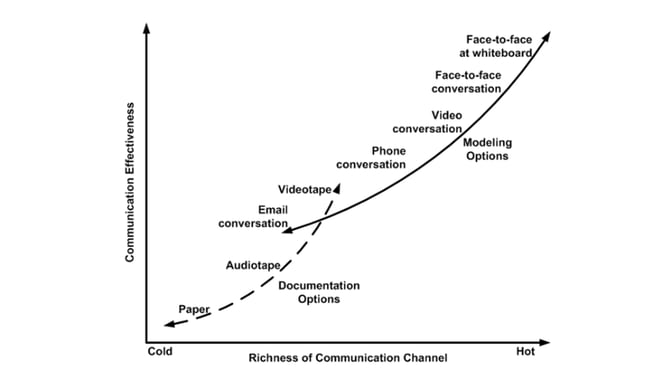How Does Agile Change With Remote Work? 7 Hacks For Distributed Teams
(Updated 01/22)
Teams that were dispersed before the pandemic used creativity and digital solutions to bring Agile methodologies to life without face-to-face meetings. So how does Agile change for everyone else in remote work?
In sum, harnessing the right tools, setting expectations for accountability, and mastering communication are key components of transforming Agile for remote teams. According to a study by Capterra, 71% of companies use Agile approaches in some form or another. We know it is a unique and effective way to manage workflows used by many in the tech industry, including the BWBacon team.
Defining Agile:
For those new to Agile, the idea behind its approach is to implement a project and divvy tasks at defined time intervals, or sprints, with a self-organized, interdisciplinary team. The overall goal is to prioritize tasks with the highest business value first. This enables teams to adapt and act quickly towards shifting requirements in every project phase.

This post will examine challenges and solutions for maintaining and building on Agile regardless of co-location. Agile, as a method of managing large deliverables and projects, wasn’t codified and popularized on a big scale until 2001, when a group of software developers wrote the Agile Manifesto. Since then, software teams have latched onto Agile techniques including waterfall methods, practicing standups, and delivering retros.
What Are The Challenges Of Agile In Remote Work?
Settling into the new normal, there is a tendency to get comfortable and let good communication slip in a digital environment. We all have a little predisposition as humans to retreat into our isolation. We stop intentionally seeking that collaboration that is such an integral part of F2F office spaces.
When brainstorming sessions are part of a scheduled, formal process, there is a different feel in coming prepared with your thoughts and ideas versus the spontaneous, organic sessions of the pre-virtual work world. Ongoing communication across remote teams is not the only struggle in trying to follow the guiding principles of Agile. Other hurdles include:
- Scheduling communication across multiple time zones
- Less clarity in roles due to lack of traditional indicators, like sticky notes
- Replicating in-person collaboration spaces and physical tools like whiteboards to virtual
- Lost communication due to sheer volume of managing more digital conversations
- Lack of team documentation on takeaways, notes, and next steps
- Less effective information sharing or unclear methods for information sharing
- Loss of culture or misalignment
The high engagement and dedication that characterize outstanding Agile teams will decrease over time if rituals cannot be reformed for WFH. Fortunately, there are schools of thought on this transformation from before the pandemic, plus stockpiles of data from last year that can guide us now. Another tenant of Agile, welcoming changing requirements and embracing a flexible mindset will allow innovative teams to carry on.
7 Solutions Rethinking Agile For Dispersed Teams
Diving into solutions for these common challenges, it is important to take stalk of your team’s motivation levels and how to help them avoid burnout. Especially for Agile teams used to rapid-fire discussions and in-the-moment interpersonal dynamics, working alone can be hard, or lonely. Start by being honest about what’s working and what’s not. Leaders must prompt these conversations and continue to create safe spaces for employees to express their needs.

- Create Ongoing Feedback Loops
- Whether you are on a team or manage a team, do you feel a shared sense of responsibility towards common goals? Do team members focus on their individual delivery or are there ways they could be helping each other? Is feedback well received?
- Particularly in remote work, there is a shared responsibility to generate feedback loops and a culture of collaboration over competition. Healthy competition can be beneficial, but more is achieved when we avoid working in silos and catch problems proactively.
- Master At-Home Productivity and Self-Discipline
- Another solution rooted in self-motivation, but can be nurtured by leadership is mastering at-home productivity. Of course, there are distractions at home with families, pets, and other routines, but these are not so far from distractions of a typical office.
- Provide your team with support and resources for managing their time. Whether this is a suggested schedule, or conversation on your team’s different good habits, you can work towards building routines that establish a healthy balance. Work is no longer 9-5, so encourage your team to experiment with different schedules and techniques for focus.
- Lean on Technology Resources, Virtual Whiteboarding, and Tools
- Leaning on new or semi-new virtual collaboration and teams’ tools including Zoom, Slack, Monday, Trello, and others requires revisiting the existing norms of your organization and how you manage tasks. Slack can function as both the team water cooler, and the place for urgent and pressing matters through direct mentions and specific channels.
- If you went to elementary school in the 90s or 2000s, you may remember programs like Kid Pix and other drawing games that were simply preparing us for this moment of screen-sharing and idea visualizations using our devices. Strap on your best illustrator shoes and realize it is never too late to adopt digital replicates for whiteboards and workflow visualization that feel more dynamic than a Power Point presentation.
- Replicate Physical Markers in Digital Spaces
- During an in-person standup, there is not much need for taking extensive notes because everyone on the team is usually there to absorb the goals moving forward. In remote work, physical markers for task management like sticky notes and whiteboards must be just as readily available online. When learning the ropes of new tech tools, be direct about how old markers will be translated and revisited. Take a look at this article for top apps that make virtual team management easy, not boring.
- Prioritize Training and Development
- A huge part of employee engagement and buy in is continuing to invest in educational and career growing opportunities. Your business only stands to benefit when those people gain new skills and bring them to the table. When talented people know they are valued, loyalty and organizational resilience go up.
- As far as development goes, use retros to help your team solve problems an improve themselves. Measure and track progress in a way that suits your customer journey or product best, and find the jumping off point. An ideal retrospective meeting promotes ownership, and explicitly lays out opportunities for teams to improve performance and make decisions.
- Define Rules for Teams, Workflows, and Accountability
- Your organization has likely gone through several iterations of this “hack” in the last year. However, true Agile form insists that there is always work to be done, a flowing, unending process of tuning and adjusting behavior accordingly.
- Is your process possibly frustrating due to lack of documentation? Expectations should be laid out, put in writing, visualized, agreed upon, and accessible by all, reducing waste automatically. You can cut down on back and forth related to role clarity, tasks, and team goals if there is documentation to answer these questions.
- Create visuals that represent your workflows and goals as much as possible. Help your team define what is essential and what is non-urgent communication, promoting better compartmentalization. In turn, the goal is that people spend their work hours in a more methodical way, and there are clear steps for accountability.
- Promote Self-Reliance and Maintain Transparency
- And finally, the most rewarding part of a well-functioning Agile team is knowing you can trust your coworkers to put in the same effort as you are. Maintain transparency about issues that arise, fluctuating timelines, and what your business stands to gain if goals are achieved. Find ways to flex your benefits for new working situations, and reward individuals showing leadership and self-motivation.
New Meeting Practices Are About Quality Over Quantity
Standups, and meetings in general, keep teams adaptable, light, and pivoting towards changing goals. Let’s focus momentarily on improving meetings. A few tweaks can banish the dreaded Zoom fatigue all together before it makes eyes and ears glaze over. Yet another principle of Agile is eliminating waste, and ongoing jokes about “this could have been an email” certainly have validity to them! When scheduling a virtual conversation, ask what is the goal of this meeting? What are we trying to accomplish?
If a meeting where you can bounce ideas off one another and see each other’s expressions is crucial, then absolutely have that meeting. Sending out expectations and goals ahead of time can be a boon for maximizing productivity and takeaways. Consider generating a story map, or ideal outcomes for the task, and how you and other collaborators might reach that goal. Ensure your entire team has easy access to the digital collaboration tools to keep ideas, notes, updates, and communication flowing.
Another meeting-related concept we could appreciate is leaving some breathing room, or space at the start of calls for catching up on a personal level. While it may take a moment longer, it cuts down on video call fatigue by giving us those small-talk, socializing endorphins that also remind us why we are working with these people, towards a collective goal. A recent survey of software developers found that 43% believed their team’s velocity had increased since the onset of COVID-19, meaning meetings are even more business and results driven then before.
But what do we stand to lose for being so hyper-focused? It’s something many companies are struggling with as of late. Nonetheless, this is still the moment to brainstorm what else we can do about loss of connection and cultural deterioration. So, dig in, and make the most out of video-calling and online chatting.

How Can Managers Help Guide Their Teams?
Our connection and relationships with one another are still based on building trust, and engaging outside our shared work. Add a daily joke to your standup or weekly challenge, even simple add-ons do a lot for creating a unified team experience. Consider reducing group sizes and rethink how you facilitate focus groups to leverage online collaboration where everyone feels heard and seen.
If an earnest effort is made, organizations can encourage bonding among team members in remote work, and develop the very “spontaneous ideas and innovation that makes agile so powerful to begin with.” Build discipline, self-motivation, and open communication incrementally. We encourage leaders to experiment with new ways of incorporating human elements into each and every day. Working remotely requires more purposeful and structured communication, so set check-ins with your people. Are they being supported and trusted to get the job done? Do you set aside intentional times for examining process and eliminating waste?
To keep things fresh, try adjusting long-term goals to short-term goals. Build in check-points and reinforce your organization’s “definitions of done” for assessing performance and progress over time. Taking the time to learn the virtual tools at your disposal will level-up your idea building and efficiency. As remote work expert Lisette Sutherland puts it, “learn how to use breakout rooms; learn how to use whiteboards; learn how to draw and design together online…the only way you can really fine-tune is if you're evaluating regularly.”
Given time, both teams practiced in Agile and those learning it, can recreate its virtues for remote work. It’s simply a framework and technique for organizing your approach to the work at hand. For additional resources, this webinar covers a lot on reinventing Agile for remote teams. A template that can be adapted across industries, it’s no wonder Agile has continued to be a backbone for teams working remotely, revitalizing its applications along the way.
Here at BWBacon Group, we know and live what you are experiencing as an employer or job seeker in Denver, Boulder, Dallas, San Francisco, New York City or any of the other cities we work in. We believe great recruiting starts and ends with understanding people.
